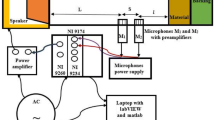Abstract
The Wenner and offset Wenner array is among the quite recent configurations used to assess and reduce the disturbing lateral effect in resistivity soundings. Even if this system could be considered as one of the most efficient configurations for this purpose so far, the restricted number of measuring points makes its vertical resolution limited. To fix this limitation, Barker found out a specific equation by which resistance values at points halfway between the actual measuring ones are computed without being measured. This aim was reached by combining expressions of electric potentials at various electrode spacings. For the same purpose, three other equations were worked out and tested. For a single sounding, resistance values were computed at intermediate points by the mean of these equations. Observational errors were also calculated using Barker’s formulae. The computed resistance values were found to be contaminated by these errors, in varying degrees to the extent that some of them were lacking reliability. Furthermore, at each electrode spacing, the differences between the interpolated and the assumed resistivity values on a straight line joining the actual measuring points were calculated. After normalizing these differences to their corresponding averages, the RMS of these normalized differences were computed for a set of soundings using the four equations. Finally, a comparison of the obtained results with the errors of measurements from the reliability of the computed resistance values was made. This comparison allowed classifying these equations from the reliability of the intermediate resistivity values perspective. In addition, Barker’s choice of one of these equations as the one that gives the most satisfactory results is justified.









Similar content being viewed by others
References
Barker RD (1979) Signal contribution sections and their use in resistivity studies. Geophys J R Astron Soc 59:123–129
Barker RD (1981) The offset Wenner system of electrical resistivity sounding and its use with a multicore cable. Geophys Prospect 29:128–143
Broadbent B, Habberjam GM (1971) A solution of the dip** interface problem using the square array resistivity technique. Geophys Prospect 19:321–338
Carpenter EW (1955) Some notes concerning the Wenner configuration. Geophys Prospect 3:388–402
Carpenter EW, Habberjam GM (1956) A tripotential method of resistivity prospecting. Geophysics 21:455–469
Dasgupta SP (1984) A note on the conversion of d.c. dipole sounding curves to Schlumberger curves. Geoexploration 22(1):43–45
Dey A, Morrison HF (1979) Resistivity modeling for arbitrarily shaped three-dimensional structures. Geophys Prospect 27(1):106–136
Ghosh DP et al (1974) Transformation of dipole resistivity sounding measurements over layered earth by linear digital filtering. Geophys Prospect 22(3):476–489
Habberjam GM (1969) The location of spherical cavities using tripotential resistivity techniques. Geophysics 34(5):780–784
Habberjam GM (1972) The effects of anisotropy on square array resistivity measurements. Geophys Prospect 20(2):249–266
Habberjam GM, Watkins GE (1967) The use of the square configuration in resistivity prospecting. Geophys Prospect 15:468–479
Koefod O (1979) Resistivity sounding on an earth model containing transition layers with linear change of resistivity with depth. Geophys Prospect 27(4):862–866
Kumar R, Das US (1977) Transformation of dipole to Schlumberger sounding curves by mean of digital linear filters. Geophys Prospect 25(4):780–789
Kumar R, Das US (1978) Transformation of Schlumberger apparent resistivity to dipole apparent resistivity over layered earth by the application of digital linear filters. Geophys Prospect 26(2):352–358
Kunetz G (1966) Principles of direct current resistivity prospecting. Geopubl. Associates, Borntraeger, Berlin
Lee FW, Swartz JH (1930) Resistivity of oil-bearing beds. US Bureau of Mines, Technical paper 448
Patella D (1974) On the transformation of dipole to Schlumberger sounding curves. Geophys Prospect 22(2):315–329
Roy A (1978) A theorem for direct current regimes and some of its consequences. Geophys Prospect 26:442–463
Sarma VVJ (1951) Modified tripotential prospecting method. Geophys Prospect 9(4):568–581
Stefanescu S et al (1932) Etudes théoriques sur la prospection electrique du sous sol II. Studii technice si economice 14(2). Institutul geologic al Rominiei, Bucuresti
Szalai S, Szarka S (2008) Parameter sensitivity maps of surface geoelectric arrays I. Linear arrays. Acta Geod Geophys Hung 43(4):419–437
Tang M (1980) Use of the second order derivatives of the potential caused by a d.c. point source in resistivity sounding method. Tap Chi Vat Ly (Physics) 5(2):19–24
Tang M, Thanh Quynh V (1981) Nature of the apparent resistivities over inhomogeneous media. Tap Chi Vat Ly (Physics) 6(3):23–31
Teisseyre R (1963) The theoretical curves of the potential-drop-ration method. Acta Geophys Polon 9(1–2):67
Acknowledgements
We are grateful to two anonymous reviewers and the associate editor Endre Turai for their constructive comments that improved an earlier version of our manuscript.
Author information
Authors and Affiliations
Corresponding author
Rights and permissions
About this article
Cite this article
Chermali, M., Bellalem, F., Belgroun, M.W. et al. Examination of the validity of the computed intermediate apparent resistivity points in the Wenner and offset Wenner configuration of sounding. Acta Geod Geophys 53, 661–677 (2018). https://doi.org/10.1007/s40328-018-0236-x
Received:
Accepted:
Published:
Issue Date:
DOI: https://doi.org/10.1007/s40328-018-0236-x




